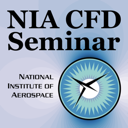 |
|
|
[Sponsors] | |||||
| CFD News and Announcements - Message Display |  |
| Post Response | Return to Index | Read Prev Msg | Read Next Msg |
| Posted By: | hiro |
| Date: | Sat, 14 Oct 2017, 5:52 a.m. |
95th NIA CFD Seminar
Topic: A Personal Journey Towards High Fidelity Rotorcraft CFD
Date: Monday, October 16, 2017
Time: 1pm-2pm (EST)
Room: NIA, Rm101
Speaker: James D. Baeder
Speaker Bio: Dr. James D. Baeder is a member of the Alfred Gessow Rotorcraft Center as Professor in Aerospace Engineering at the University of Maryland; he is currently the Associate Langley Professor Chair at the National Institute for Aerospace. He holds a B.S. in Mechanical Engineering from Rice University and M.S. and Ph.D. in Aeronautics and Astronautics from Stanford University. He joined the AGRC in 1993 after nine years at AFDD. His research interests are in developing and applying Computational Fluid Dynamic methods to better understand and predict rotary and flapping wing aerodynamics, acoustics and dynamics. One of his key research thrusts is the development of multi-fidelity coupled CFD/ free-wake/ structural dynamics/ acoustic methods. His pioneering efforts in predicting high-speed vibration and noise of helicopters, together with Dr. Chopra, are leading to a better understanding of the physical mechanisms responsible for the large increase in vibrations at such conditions. Additional applications include simulating: the use of active elements; helicopter “brownout”; interactional aerodynamics; aerodynamic performance and flow-field of small-scale rotary and flapping UAV; vertical axis wind turbines (VAWT); and offshore wind turbines. Currently he is pioneering the development of improved CFD algorithms, with a focus on GPGPU technology, to: capture the details of laminar/turbulent transition; dynamic stall; as well as tip vortex formation, convection and interaction with other surfaces including fuselages, towers or the ground and including adjoint capabilities. Dr. Baeder’s research has been funded by Excelon, NASA Ames and Langley, the Army Aeroflightdynamics Directorate, the Army Research Office, the National Rotorcraft Technology Center, NAVAIR and DARPA, with support from the various helicopter companies. He has authored more than 45 archival journal articles. He received the 1993 Schroers Award for Outstanding Rotorcraft Research from the San Francisco Bay Area Chapter of the AHS and the 2010 AIAA National Capital Section Engineer of the Year Award. He advised the University of Maryland team to receive First Place in the Undergraduate Category of the 2017 American Helicopter Design Competition. Dr. Baeder is an Associate Fellow of AIAA and a member of AHS. He currently chairs the Innovation and Commercialization Committee of the Business Network for Offshore Wind as well as the National Offshore Wind Innovation Center.
Abstract: In the 1980’s it was sufficient for CFD to look at very simplified model rotorcraft problems, for example: a 2-D airfoil encountering an isolated prescribed vortex or a non-lifting isolated rotor blade in forward flight generating unsteady shock waves. In most instances the inviscid Euler equations were used or else the flow was assumed to be fully turbulent and an algebraic turbulence model was used for closure. While relatively unsophisticated by today’s standards, they were able to provide some key physical insights into such phenomena as blade-vortex interactions and high-speed impulsive noise. It also served to pique interest in the rotorcraft community as to how CFD could be applied to practical problems. High fidelity rotorcraft aerodynamic simulations are inherently multi-disciplinary and require hybrid methods to resolve all relevant fluid scales. Thus, applications of computational fluid dynamics to rotorcraft over the past 25 years have required an increase in the level of sophistication not only of the included physics but also of more complicated configurations with more complex geometries. As a result this has necessitated not only increased computer hardware, but also the development of more sophisticated algorithms. The first part of this seminar will discuss the wide range of improvements made to rotorcraft CFD simulations at the Alfred Gessow Rotorcraft Center over the past 20+ years. In regards to multi-disciplinary physics this includes such areas as: aeroacoustics, structural coupling and trim, low Reynolds number and low Mach number flows, laminar/turbulent transition, two-phase flow (particles in fluids), and the capturing of tip vortices and other large eddies. These have been accompanied by algorithmic improvements that have included: hybrid Eulerian/Lagrangian methods for wake coupling, vortex tracking grids, compact reconstruction of inviscid fluxes, hybrid RANS/LES turbulence modeling, and GPGPU programming. More complicated geometries have been enabled through: implicit hole-cutting for overset meshes, simplified models for flaps and other actuators, and the use of unstructured meshes. The second part of the seminar will focus on the application of uncertainty quantification to look at the effect of uncertainty in free-stream turbulence intensity levels on 2-D airfoil integrated forces and moments as well as flow physics.
Additional information, including the webcast link, can be found at the NIA CFD Seminar website:

| Post Response | Return to Index | Read Prev Msg | Read Next Msg |
